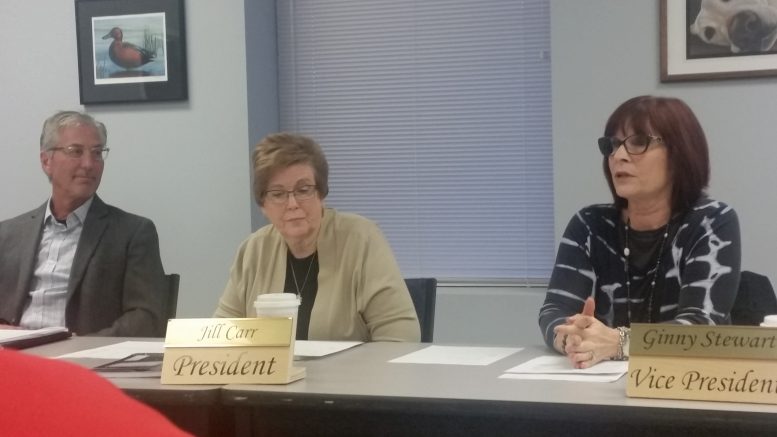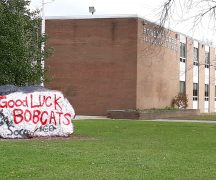By JAN LARSON McLAUGHLIN
BG Independent News
Bowling Green City Schools will be asking voters in May to reconsider the same issue they rejected in November.
The board voted 4 to 1 this morning to return to the ballot in May with a bond issue for 37 years for a consolidated elementary school, plus renovations and an addition to the high school.
“The longer we wait, the costs go up,” board member Ginny Stewart said during the special meeting. “We continue to put good money into inferior buildings.”
The only difference to appear on the ballot may be a reduction in the millage due to the growth in the assessed valuation. That may drop the millage from 6 mills in November to 5.7 mills in May. That in turn would reduce the amount it would cost the owner of a $100,000 home from $210 a year to $199 a year.
Board President Jill Carr reminded the board that their decisions included exactly what issue will go on the ballot, when it will go before voters, and whether the issue should remain as one or be split into two.
The lone vote against returning with the same ballot request came from board member Bill Clifford. He emphasized that he believes the consolidated elementary and the high school improvements are needed – but he thinks putting them on the ballot as two separate issues gives at least one a better chance of passing.
“It is the best plan, that has not changed in my point of view,” Clifford said of the district’s overall building plan. However, he’s heard from voters who would like to see a reduction in the scope of the $72 million project.
“I’m getting a lot of feedback,” Clifford said. “I hear about ‘bells and whistles.’ I hear ‘Taj Mahal.’”
The board looked for ways to trim costs, but could not make cuts without hitting vital parts of the project, he said.
“That was something we just could not do. This was the best plan. It remains,” he said.

Board member Bill Clifford expresses his concerns.
Stewart agreed.
“This is bare bones. We are not asking for anything that is extraordinary,” she said. “I think that’s important for the public to understand.”
The only real option for cutting costs would be for the district to build the consolidated elementary school with fewer than the proposed 12 classes per grade level, Superintendent Francis Scruci said. But that would mean more room would be needed when the district experienced future growth.
“That would be a quick way for having us all strung up in the middle of town,” Scruci said.
Board member Paul Walker said district’s initial request remains the “ideal.”
The newest board member, Norm Geer, who was elected to the school board the same night the levy failed, said he has heard from citizens who are concerned about the levy – not about its scope, but about its success.
Nine out of 10 people want the school district to try the same issue again, Geer said. “The people I’ve talked to want this back on the ballot just as it is.”
As he drove past Conneaut Elementary earlier this week, Geer said he was reminded of attending the school 60 years ago. “I was a safety patrol at that intersection.”
It was a good school, “but things have changed,” he said. “The buildings can’t stay as they are.”
The district’s proposal for a consolidated elementary is a functional plan.
“This plan, as ambitious as it is, is a sound, no-frills plan,” Geer said. And like any improvement, “there’s a cost that goes with it.”
Clifford stressed throughout the meeting that he believes in the need for the building projects, but that his concern lies in getting the millage passed at the polls.
“I’m supportive of this project,” he said. “I remain concerned, like we all are, about the passage of this project.” By splitting the building projects into two different issues, the taxpayers may be more likely to support one or the other, Clifford said.
“I think we have a better chance that way,” he said.
Carr said after the meeting that the board will be looking at different strategies to get more voter support for the issue. “We have to figure out a plan,” she said. But the board has less than four months to convince voters before the May 8 election.
“That’s not a whole lot of time,” Carr said.
Last year, Scruci made more than 100 public presentations on the building plans and bond issue.
“We’ll be looking at where did we fall short. And how to get more than 25 percent to come out to vote,” Scruci said after the meeting. “We have to show our community how important this is.”
Scruci also plans to attack misinformation that he believes hurt the last levy attempt.
“Our job at this point is we need to clean up misconceptions,” he said.
The major misconception is that Bowling Green City Schools turned down state money for the building project.
“Our district was never offered money by the state,” Scruci said.
In fact, the revised property valuations for Wood County put the district even further down on any list for possible funding, he said. The state ranking is based on the property valuations divided by the number of students. Bowling Green ranks 520 out of 610 districts.
“We’re at the bottom of the list,” Scruci said. If the district qualified, it would be for 10 to 12 percent state funding. “There is a total misunderstanding that we were offered money and we turned it down.”





